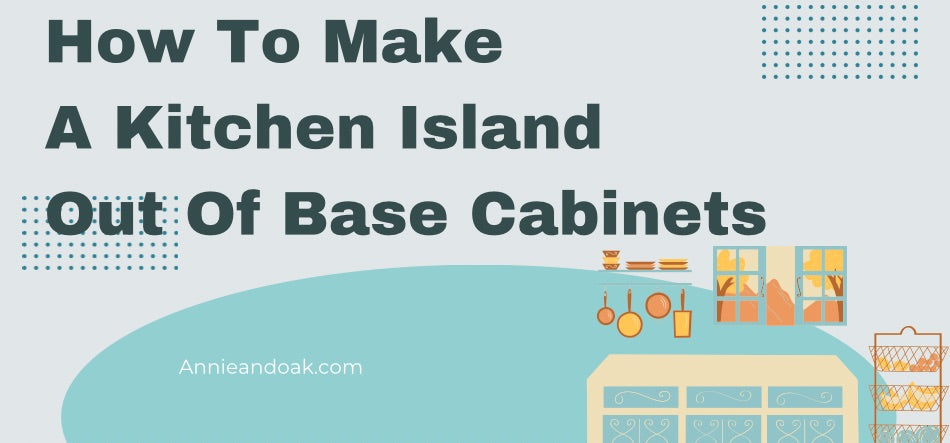
How To Make A Kitchen Island Out Of Base Cabinets

You might be in the kitchen renovation process and have the space for an island, but you have no idea how to make one and want to save costs from having a contractor build it.
This undertaking can seem an impossible task, but it's very achievable if you follow the step-by-step guide.
We have provided the materials you'll need, plus any measurements and factors that may help you get the best use of your kitchen space, so if you want to upgrade your kitchen's look, read on to find out more.
Materials You'll Need
- Base cabinets
- Matching toe kick finishing panel
- Standard 2" x4" x8' length of wood
- Shims
- 2 - ½ inch drywall screws
- 2 - ½ inch cabinet screws
- 1 inch, 18 gauge brad nails
- .22 caliber single shot powder loads
- 2-½ inch dry pins or 1-½ inch drywall screws
Tools You'll Need
- Impact driver
- Drill
- Level
- .22 caliber single shot tool
- Pneumatic nailer
- Air compressor
- Countersink drill bit set
How To Make Your Island

Step 1
First, you want to determine and mark out the placement and size of the kitchen island, so to help you work this out, the recommended space around a kitchen island is around 42-48 inches, and a larger area is preferable if your kitchen is big enough.
You might want to avoid installing the island if you don't have at least 36 inches of space around all sides.
Otherwise, getting around the kitchen is going to be a bit of a squeeze, and with all those cupboard doors opening, you're going to want as much room as possible.
The length of the island is down to your preference as you can make different combinations and standard base cabinets go all the way down to 9 inches, so you have flexibility in this area.
Now you want to work out how much overhang you want if you decide to have people sit by the island and have plenty of room to fit legs.
Any length over 12 inches will need supports, so consider going smaller if you want to save costs.
Step 2
Now you have these dimensions, you can work out how many cabinets you'll need to make the island.
Now you want to cut and secure as many 2x4s as there are base cabinets into the floor, which gives it a solid foundation.
When screwing these into the floor, you want to measure from the wall and add two inches to account for any cupboard handles and tabletop overhang.
With a wood subfloor, you can screw the 2×4 into the floor using 2-½ inch drywall screws.
You want to make sure it is square as the cabinets are going to slide against the supports, and you can repeat this step for each cabinet you install and make sure you space out each support so each cabinet can sit on its support easily.
Step 3
Now you want to screw the base cabinets together and into the supports you've put down.
Start with the center base cabinet and place it on top of the support, ensuring the front of the cabinet is pushed tightly against the support.
Then use your level and some shims to level out the base cabinet once it's level, then pre-drill and screw through the foot of the cabinet into the side of the support using 2-1/2 inch drywall screws.
Then you can move onto the second cabinet and Pre-drill it using a countersink drill bit and screw through the side of that cabinet to secure it to the other cabinet, ensuring that the faces stay flush as you install them.
Then screw through the foot of the other cabinet using 2-1/2 inch drywall screws into the side of the support to secure it into place at the bottom as well.
Repeat this process until all base cabinets are secured together, and then you can go on to add the finishing pieces.
Step 4
You can install the back panel, toe kick panel, countertops, and kitchen handles.
To install the countertop, you'll need to cut wood spacers to the base cabinets' depth to prop the countertop's edge above the drawer faces, then you want to apply liquid nails to both sides of the spacers.
Then you can place the spacers on top of the base cabinets, then lay the countertop on top of the spacers, and screw through the base cabinet into the spacer and into the bottom of the countertop.
Once you have the countertop on, you can install the toe kick panel by cutting it to size and nailing it into place with 1-inch 18 gauge brad nails, then you can add the handles to the cabinets, which should be easy enough with the screws that normally accompany the handles.
That's it, now, you can style your island with chairs, decorations, or whatever you want to spruce up the kitchen for your requirements.
It might be a good point here to go around and round off any juttering edges or fix any test out the cabinet doors to ensure everything fits and works properly.
Conclusion
Now you know how to install a kitchen island, the next step is to work out how you can style the rest of your kitchen to bring the look together.
Be aware, though, that if you want to have laminate or vinyl plank flooring, you'll want to install the island before you lay this flooring, as this type of flooring is meant to rise a bit and not be locked down.
If you're flooring is nailed or glued down, then you can lay the island over the top as usual, and with this type of flooring, it tends to be thin so that you can put down other flooring over the top.
This can be a great option if ever you decide you want a different style of floor and make your kitchen the pride of your home. Thank you for reading.






